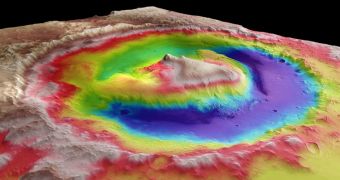As the NASA Mars Science Laboratory (MSL) mission is moving ever closer to its destination, experts at space agencies around the world are getting ready to support Curiosity's deployment. Such is the case with the European Space Agency as well, which will use the Mars Express orbiter for the job.
The spacecraft has already contributed extensively to the NASA endeavor, primarily by helping researchers at the agency's Jet Propulsion Laboratory (JPL) narrow down the landing ellipse for the 1-ton rover. Curiosity is about the size of a Mini Cooper, its designers say.
Though originally much larger, the landing ellipse for the groundbreaking robot is now just 20 x 7 kilometers (12.4 x 4.3 miles). This means that it will land closer to its intended target, Mount Sharp, and reduce the amount of time it spends on the road by several months.
Mount Sharp is 5-kilometer (3-mile), gently-sloped mountain in the middle of Gale Crater. Curiosity will land very near to the structure, and then attempt to climb its slopes, while conducting numerous chemical analyses of its materials. The primary science mission is scheduled to last for at least 2 years.
As the MSL aeroshell will enter our neighboring world's atmosphere, its path will be monitored by Mars Express, the NASA Mars Reconnaissance Orbiter (MRO) and the long-lived Mars Odyssey,
Since, by the time the rover lands, Earth would have already passed behind the horizon at Gale Crater, the three orbiters will be absolutely essential to establishing communications between JPL Mission Control and Curiosity, via the NASA Deep Space Network.
Unlike the two American spacecraft, Mars Express will send its data to the New Norcia, Australia-based ESA listening station, which will then immediately relay the information to the European Space Operations Center (ESOC), in Germany. From there, the data will immediately reach JPL.
MSL is the first mission dedicated to figuring out whether life is, or was, ever possible on the surface of the Red Planet. The rover will investigate these questions by collecting a variety of rock samples, and conducting multiple analyses on their chemical makeup.
Curiosity is scheduled to land at 10:31 pm PDT on August 5 (01:31 am EDT, 0531 GMT on August 6). In order for it to be successfully settled on the Martian surface, the new Sky Crane landing system has to operate flawlessly.
Around 76 pyrotechnic blasts also need to occur at precise intervals. Despite the challenges associated with landing this heavy robot on Mars, JPL experts are convinced that everything will go according to plan.

 14 DAY TRIAL //
14 DAY TRIAL //